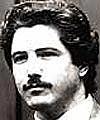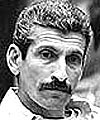  |
A more dangerous team of blood relatives was composed of the two cousins who came to be known as the Hillside Stranglers. October 17, 1977, Yolanda Washington, 19, was picked up, strangled, and dumped near the entrance to Forest Lawn Hollywood Hills Cemetery. Ted Schwartz, author of The Hillside Strangler, said that the killers' MO was to pretend to be police officers making an "arrest." Their first three victims were prostitutes, and they would pick them up, have sex with them—often while bound--kill them, and dump them by the roadside. The second victim, Judy Miller who was 15, was found on Halloween. According to Corey Mitchell in Hollywood Death Scenes, she had been laid in a garden on an anthill and her legs had been posed in the shape of a diamond. It was clear that she had been trussed up with ligatures while alive and then strangled. A white fiber was found on her eyelid. At that moment, it meant nothing, but it would prove to be a significant piece of evidence. A week later, another woman was found in Glendale, California, on a golf course. She was 21 and she joined Miller, who had not yet been identified, in the morgue. On November 20, two victims were discovered who had been abducted from a mall. They were 12 and 14, and they were not prostitutes. Their bodies had been rolled down a 50-foot embankment into a trash heap. The same night produced a sixth victim and all of her bruises matched those of the others. She had been an art student and was on her way home from class. "That put a little panic in the city," said retired LA sheriff's detective Frank Salerno for Court TV's Mugshots. He had been involved with the Los Angeles investigations. Now that it was clear that women were being killed at random and in rapid succession, people all over the city were afraid. In three days, an actress, 28, was found alongside a freeway exit ramp. A business student became the eighth victim on November 28, but she had burns in the palms of her hands as if from electrocution. That was a new twist, yet she was linked to the others by a common MO. Thousands of tips were called in and the media dubbed the killer The Hillside Strangler. Yet police believed there had to be two. Another murdered prostitute was soon found naked on the side of a hill. She appeared to have been posed in a spread-eagle fashion as some kind of insulting statement. This time there were witnesses who had seen two males with her. That was clear evidence that more than one killer was at work, but then the leads dried up. They were at a dead end. All of a sudden, the murders stopped as quickly as they had begun. Police waited through the holidays with no new bodies clearly linked to the spree. Then on February 17, 1978, the highway helicopter patrol spotted an orange compact car crashed off a highway, and locked inside the trunk was victim number 10: Cindy Hudspeth, 20. She had been strangled and also had ligature marks. A witness came forward to describe the person who had been driving the car, but once again, they made no arrests. Then nothing else happened. Months went by and there were no new deaths. Yet the killers had not stopped; one of them had simply left town with his girlfriend. Kenneth Bianchi Almost a year after the last Los Angeles victim was discovered, in Bellingham, Washington, college roommates Diane Wilder and Karen Mandic were reported missing. On January 12, 1979, a security officer said that one of them had indicated they were going to do a security job for Ken Bianchi, a good-looking man with a girlfriend and infant son who was a captain at the security company. They thought this was not a first murder, since it was carefully done. They picked up Bianchi for questioning and collected trace evidence, which turned up three important items: * carpet fibers on the bodies that matched those from inside the house * a lint brush in Bianchi's home with fibers from the house and hairs from one of the girls * pubic hair on one girl, which matched Bianchi They then linked him through his California drivers' license with the string of the Los Angeles murders from the year before, and it turned out he had jewelry in his home from two of those girls. It didn't take long to connect him with his cousin, Angelo Buono, who ran a car upholstery shop near many of the body dumpsites. Angelo Buono, police files An eyewitness took the stand who had seen one abduction. He described the car and Angelo Buono as the driver. Fibers on another victim had come from a chair in Buono's house. They also matched material from Buono's upholstery shop to the fiber on the eyelid of the first victim. The trial lasted two years with a parade of 250 witnesses and a thousand exhibits. On Halloween 1983, the jury convicted Buono of nine of the ten murders and gave him nine life sentences. Bianchi, who had pleaded to five, was given five life sentences on top of the two he had in Washington.
A more dangerous team of blood relatives was composed of the two cousins who came to be known as the Hillside Stranglers. October 17, 1977, Yolanda Washington, 19, was picked up, strangled, and dumped near the entrance to Forest Lawn Hollywood Hills Cemetery. Ted Schwartz, author of The Hillside Strangler, said that the killers' MO was to pretend to be police officers making an "arrest." Their first three victims were prostitutes, and they would pick them up, have sex with them—often while bound--kill them, and dump them by the roadside. The second victim, Judy Miller who was 15, was found on Halloween. According to Corey Mitchell in Hollywood Death Scenes, she had been laid in a garden on an anthill and her legs had been posed in the shape of a diamond. It was clear that she had been trussed up with ligatures while alive and then strangled. A white fiber was found on her eyelid. At that moment, it meant nothing, but it would prove to be a significant piece of evidence. A week later, another woman was found in Glendale, California, on a golf course. She was 21 and she joined Miller, who had not yet been identified, in the morgue. On November 20, two victims were discovered who had been abducted from a mall. They were 12 and 14, and they were not prostitutes. Their bodies had been rolled down a 50-foot embankment into a trash heap. The same night produced a sixth victim and all of her bruises matched those of the others. She had been an art student and was on her way home from class. "That put a little panic in the city," said retired LA sheriff's detective Frank Salerno for Court TV's Mugshots. He had been involved with the Los Angeles investigations. Now that it was clear that women were being killed at random and in rapid succession, people all over the city were afraid. In three days, an actress, 28, was found alongside a freeway exit ramp. A business student became the eighth victim on November 28, but she had burns in the palms of her hands as if from electrocution. That was a new twist, yet she was linked to the others by a common MO. Thousands of tips were called in and the media dubbed the killer The Hillside Strangler. Yet police believed there had to be two. Another murdered prostitute was soon found naked on the side of a hill. She appeared to have been posed in a spread-eagle fashion as some kind of insulting statement. This time there were witnesses who had seen two males with her. That was clear evidence that more than one killer was at work, but then the leads dried up. They were at a dead end. All of a sudden, the murders stopped as quickly as they had begun. Police waited through the holidays with no new bodies clearly linked to the spree. Then on February 17, 1978, the highway helicopter patrol spotted an orange compact car crashed off a highway, and locked inside the trunk was victim number 10: Cindy Hudspeth, 20. She had been strangled and also had ligature marks. A witness came forward to describe the person who had been driving the car, but once again, they made no arrests. Then nothing else happened. Months went by and there were no new deaths. Yet the killers had not stopped; one of them had simply left town with his girlfriend. Kenneth Bianchi Almost a year after the last Los Angeles victim was discovered, in Bellingham, Washington, college roommates Diane Wilder and Karen Mandic were reported missing. On January 12, 1979, a security officer said that one of them had indicated they were going to do a security job for Ken Bianchi, a good-looking man with a girlfriend and infant son who was a captain at the security company. They thought this was not a first murder, since it was carefully done. They picked up Bianchi for questioning and collected trace evidence, which turned up three important items: * carpet fibers on the bodies that matched those from inside the house * a lint brush in Bianchi's home with fibers from the house and hairs from one of the girls * pubic hair on one girl, which matched Bianchi They then linked him through his California drivers' license with the string of the Los Angeles murders from the year before, and it turned out he had jewelry in his home from two of those girls. It didn't take long to connect him with his cousin, Angelo Buono, who ran a car upholstery shop near many of the body dumpsites. Angelo Buono, police files An eyewitness took the stand who had seen one abduction. He described the car and Angelo Buono as the driver. Fibers on another victim had come from a chair in Buono's house. They also matched material from Buono's upholstery shop to the fiber on the eyelid of the first victim. The trial lasted two years with a parade of 250 witnesses and a thousand exhibits. On Halloween 1983, the jury convicted Buono of nine of the ten murders and gave him nine life sentences. Bianchi, who had pleaded to five, was given five life sentences on top of the two he had in Washington. |